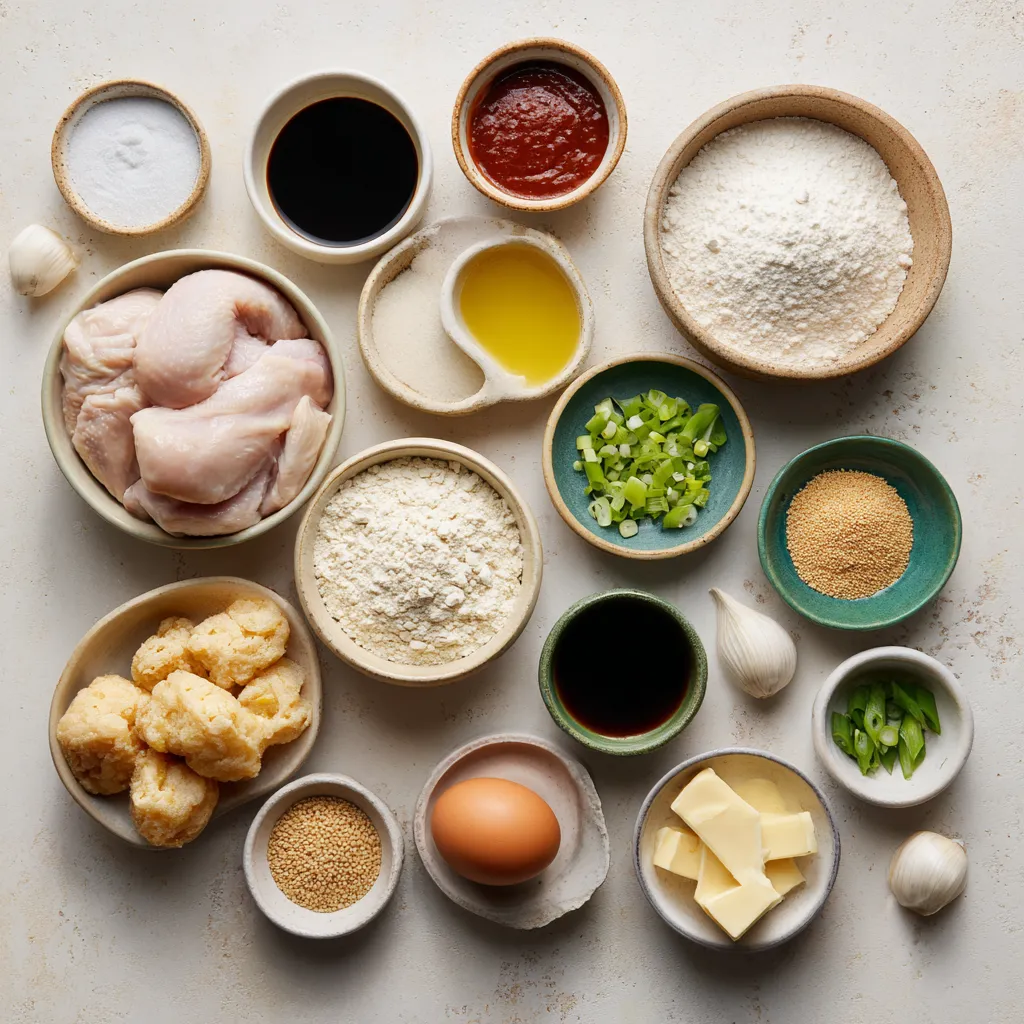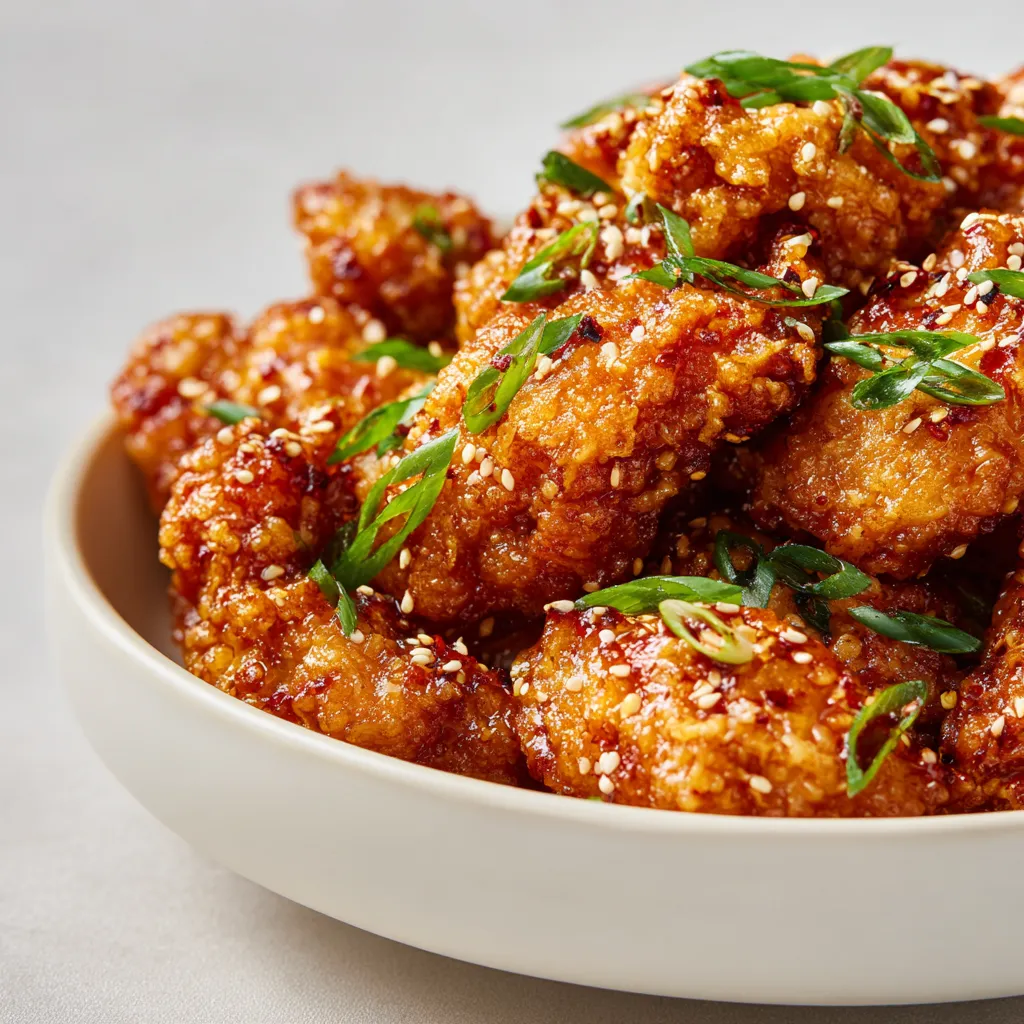Introduction
Korean fried chicken stands out as a beloved dish, known for its irresistibly crisp texture and rich flavors. This popular culinary delight has become a global favorite, frequently spotted at parties, celebrations, and casual gatherings. With its origins rooted deeply in Korean culture, this style of fried chicken is not only a meal but a delightful experience that encapsulates the heart and soul of Korean cuisine.
The combination of a tender chicken inside enveloped in a crunchy, golden-brown exterior creates a tantalizing contrast that is hard to resist. Flavored with traditional ingredients such as gochujang and sesame oil, each bite is a perfect blend of savory, slightly spicy, and umami-rich notes that dance on the palate. It’s not just about eating; it’s about savoring the moment with family and friends, making this dish an ideal choice for various occasions.
Served hot and often accompanied by refreshing pickled vegetables, crispy Korean fried chicken appeals to the senses and delivers pure comfort food satisfaction. Whether you’re indulging during a cozy night in or showcasing your culinary skills for a gathering, this recipe promises flavor and texture that will leave a lasting impression.
Recipe Overview
– Total Time: 4 hours (includes marinating time)
– Servings: 4-6
– Difficulty: Not specified in the recipe
This crispy Korean fried chicken recipe combines the popular techniques of marinating and frying to achieve that perfect crunch. The chicken is first marinated in a flavorful mixture that ensures it is moist and packed with flavors, followed by a thorough coating in potato or cornstarch before frying. This method not only maintains the chicken’s juiciness but also creates that signature crispy texture.
The dish is beautifully versatile, making it an excellent option for gatherings where comfort food cravings are high. Whether served as the main dish or as an appetizer, it is sure to please a crowd.
Ingredients
– 1.5 lbs of chicken wings or thighs, bone-in and skin-on
– 1 cup potato starch (or cornstarch for dusting)
– 2 cups buttermilk
– 1 tablespoon soy sauce
– 1 tablespoon gochujang (Korean chili paste)
– 1 tablespoon freshly minced ginger
– 1 tablespoon freshly minced garlic
– 1 teaspoon sesame oil
– 1 teaspoon salt
– 1 teaspoon black pepper
– 1 teaspoon garlic powder
– Oil for frying (such as vegetable or canola)
– Sesame seeds and chopped green onions for garnish
The ingredients listed above play pivotal roles in creating the distinctive taste and texture of crispy Korean fried chicken.

Marinating the Chicken
Marinating is one of the critical steps that sets this recipe apart, helping to infuse the chicken with rich flavors while ensuring it stays juicy throughout the frying process. The marinade consists of buttermilk, soy sauce, gochujang, ginger, garlic, sesame oil, and an array of seasonings that deliver depth and character to the dish.
To begin the marination process, one must whisk together the buttermilk, soy sauce, gochujang, minced ginger, minced garlic, sesame oil, salt, black pepper, and garlic powder in a spacious bowl. This blend creates a creamy and spicy mixture that clings to the chicken while also tenderizing it.
Once the marinade is well combined, add the chicken pieces, ensuring each piece is completely enveloped by the mixture. Cover the bowl and refrigerate for at least 2 hours, but allowing the chicken to marinate overnight is recommended for the best flavor infusion. This extended marination time works wonders in allowing the flavors to penetrate deeply into the meat.
As you coat the chicken, make sure every inch is covered to maximize flavor absorption. This is a crucial step that not only enriches the chicken but also helps in developing that crispy crust later when fried.
Preparing for Frying
After the marination period, it’s essential to prepare the chicken for frying properly. Begin by removing the chicken from the fridge and letting the excess marinade drip back into the bowl. This helps create a better coating on the chicken, ensuring that it doesn’t become too wet and clumpy during the frying process.
Next, in a separate shallow dish, place the potato starch. Potato starch is favored for its ability to create an extra-crisp exterior when fried. One by one, dredge each chicken piece in the potato starch, ensuring that it is coated evenly. This step is vital; an even coating will yield that desirable crunch while keeping the meat tender. If using cornstarch as an alternative, it serves a similar purpose but may impart a slightly different texture.
As you prepare the frying station, make sure to have a reliable thermometer handy to monitor the oil’s temperature. This ensures that the chicken cooks evenly and achieves that golden brown color — a hallmark of great fried chicken. Using oil such as vegetable or canola is recommended due to their high smoke points, making them ideal for frying.
With preparation complete, you are ready to embark on the frying process, where the marinated and coated chicken transforms into deliciously crispy Korean fried chicken.

Heating the Oil
Best practices for oil temperature are crucial for achieving that signature crispy texture in fried chicken. Begin by using a heavy-bottomed deep skillet or a Dutch oven that can withstand high temperatures. This will help to distribute heat evenly, reducing the risk of hot spots that can lead to uneven frying.
Using a thermometer is essential to ensure accuracy when heating the oil. A deep-frying thermometer clipped to the side of the pot will provide a reliable reading. The ideal frying temperature for crispy chicken is around 350°F (175°C).
Visual cues can also help determine oil readiness. When you see small bubbles forming around the edges of the pot, it’s a sign the oil is heating up. You can also drop a small piece of the coated chicken into the oil; if it sizzles immediately, the oil is ready for frying. If it sinks without bubbling, the oil is not hot enough, and if it bubbles furiously and immediately browns the chicken, it is too hot, requiring you to reduce the heat or wait briefly.
Frying the Chicken
The batch frying method is crucial in maintaining control over the cooking process. When frying chicken, it is essential to avoid overcrowding the pan, which can lead to a drop in temperature and cause the chicken to steam rather than fry. Instead, work in small batches. This ensures that the chicken pieces have enough space to cook evenly and maintain that desired crispy coating.
Cooking times are generally about 8-10 minutes on each side, but factors such as chicken piece size and oil temperature can affect this. Start checking for doneness at the lower end of this range. It’s important to note that chicken wings may cook slightly faster than thighs due to their smaller size.
When flipping the chicken, use tongs to gently turn each piece rather than a fork, which can pierce the coating and allow juices to escape, resulting in a less juicy chicken. Monitoring doneness is key; a meat thermometer inserted into the thickest part of the chicken should read 165°F (75°C) to confirm the chicken is fully cooked.
Draining Excess Oil
Effectively draining excess oil from the fried chicken helps maintain its crispiness. After removing the chicken from the frying oil, use a slotted spoon to allow excess oil to drip off. Next, place the chicken on a wire rack set over a baking sheet. This method promotes air circulation around the chicken, helping to keep it crispy.
In contrast, if you opt for paper towels, be mindful that while this absorbs excess oil, it may cause the chicken to lose some crispness by trapping moisture.
To maintain the crunchiness after frying, avoid covering the chicken with foil or placing it in a closed container, as steam can accumulate and lead to sogginess. Instead, keep the fried chicken on a rack until you are ready to serve.
Serving Suggestions
Presentation is an important aspect when serving crispy Korean fried chicken. Arrange the chicken pieces on a large platter, allowing for optimal display. A vibrant visual can be achieved by pairing the fried chicken with colorful sides like pickled radishes, which not only enhance the look but also their crunchiness and flavor profile.
Consider garnishing the fried chicken with sesame seeds and freshly chopped green onions. These add texture and a pop of color, elevating the overall dish.
Additionally, providing a few sauce options can enhance the eating experience. Aside from the traditional gochujang sauce, consider a sweet soy glaze or a garlic soy dipping sauce for an alternate flavor.
Flavor pairings are essential; serving the chicken with a side of steamed sticky rice or a simple salad can balance the meal.
Flavor Profile Analysis
The flavor profile of crispy Korean fried chicken creates a layered, complex taste experience. The marinade, composed of ingredients like gochujang, ginger, and garlic, brings a balance of heat, earthy tones, and a subtle sweetness. Each component of the marinade not only seasons the chicken but also contributes to the depth of flavor during the frying process.
The frying itself adds additional layers; the golden-brown outer layer forms through the Maillard reaction, which generates delightful savory notes, enhancing the already robust flavors from the marinade. Each bite provides a textural contrast: the crispiness of the coating against the juicy, tender chicken is a hallmark of well-executed fried chicken.
Variations and Customizations
While the recipe provides a classic approach, exploring potential ingredient swaps can cater to various culinary preferences. For those looking for a spicier kick, increasing the gochujang quantity or adding crushed red pepper flakes could elevate the heat profile.
For gluten-free options, consider using alternative coatings such as rice flour or chickpea flour instead of potato starch. This adaptation allows those with gluten sensitivities to enjoy the crispy texture without compromising flavor.
Garnishes can also be modified for varied flavor profiles; for instance, drizzling a sweet chili sauce or adding finely chopped cilantro can introduce new taste dimensions while maintaining the dish’s authenticity.
Storing Leftovers
Best practices for storing fried chicken involve ensuring it remains fresh and crispy. Allow any leftover chicken to cool completely before transferring it to an airtight container. Store in the refrigerator for up to 3 days.
For reheating, avoid the microwave, as it can make the coating soggy. Instead, preheat an oven to 375°F (190°C) and place the chicken on a wire rack over a baking sheet. Heat for about 10-15 minutes or until warmed through. This method helps restore some of the original crispiness.
If you want to freeze leftover chicken, place it in a single layer on a baking sheet to firm up before transferring to a freezer-safe container. When ready to eat, the same oven reheating method can be employed.
Conclusion
Crispy Korean fried chicken offers a delightful combination of textures and flavors that stand out with its crunchy exterior and juicy interior. The marinating and frying processes create an unparalleled taste experience. While best enjoyed fresh, careful storage and reheating methods can yield satisfying results in leftover servings.


